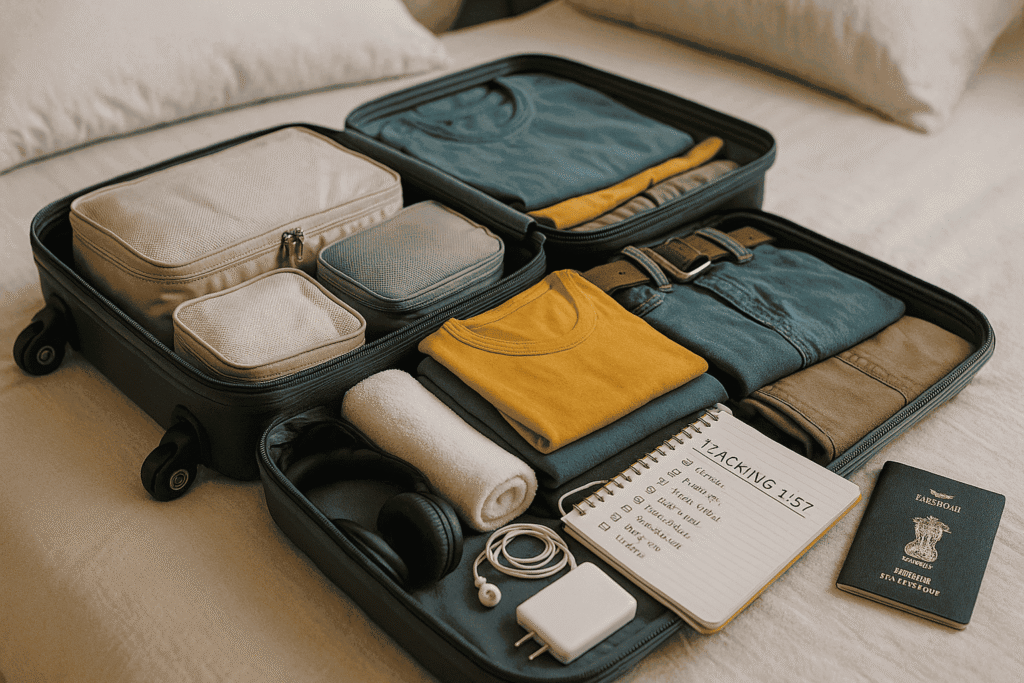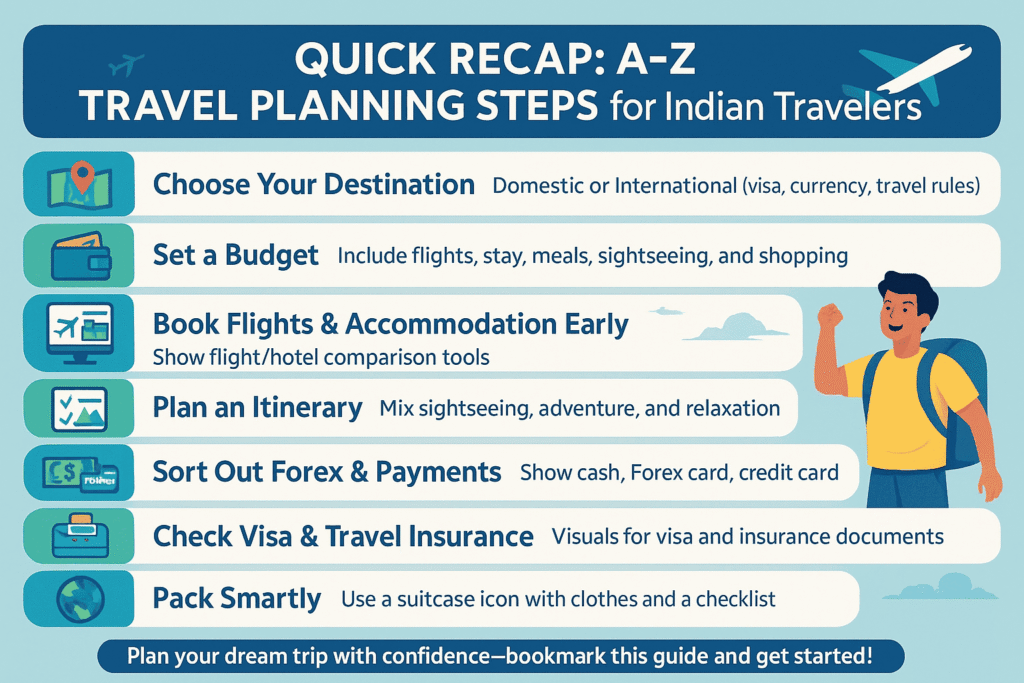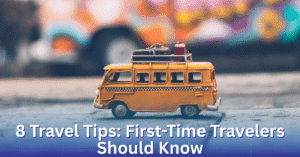Table of Contents
One can be confused about planning a trip, especially when there are so many places to visit, budgets, and logistics to take into account. If you are exploring the beautiful sceneries of India or going farther, a trip that has been well organized will provide you with a stress-free and rewarding experience.
The guide covers all topics from how and where to locate a place to money, to the most common things that need to be carried, and at the same time, to get the utmost satisfaction out of the whole adventure. Going into the tiniest details, it does not matter if you are going alone, with some mates, or taking your family away on holidays, this guide will be focused exclusively on Indian travelers right from the start.
Understanding Your Travel Goals
Before diving into the logistics, it’s essential to introspect:
- Purpose of Travel: Are you seeking relaxation, adventure, cultural immersion, or perhaps a mix?
- Budget Constraints: Determine a realistic budget, factoring in accommodations, transportation, meals, and activities.
- Travel Companions: Solo trips differ vastly from family vacations or group tours.
- Duration: The length of your trip will influence destination choices and itinerary planning.

Step 1 – Decide on Your Destination
ⅰ. Domestic Travel: Best Places to Visit in India
- Mountains & Hill Stations: Manali, Shimla, Darjeeling, Ooty, Munnar
- Beaches & Islands: Goa, Andaman & Nicobar, Gokarna, Kerala Backwaters
- Heritage & Cultural Spots: Rajasthan, Hampi, Varanasi, Khajuraho
- Adventure Destinations: Rishikesh (rafting), Ladakh (biking), Meghalaya (trekking)
ⅱ. International Travel: Visa-Friendly Countries for Indians
- Visa-Free Countries: Maldives, Bhutan, Nepal
- Visa-on-Arrival Countries: Thailand, Mauritius, Seychelles
- Easy e-Visa Countries: Dubai (UAE), Turkey, Sri Lanka, Vietnam
Choosing between a domestic or international trip depends on factors like budget, time, and personal interests. If you’re traveling internationally, research visa processes, flight connections, and local expenses.
Step 2 – Best Time to Travel
ⅰ. Best Seasons for Travel in India
- Summer (March–June): Ideal for hill stations like Manali, Mussoorie, and Darjeeling.
- Monsoon (July–September): Best for lush greenery in Kerala, Meghalaya, and Coorg.
- Winter (October–February): Perfect for Rajasthan, Goa, and snow destinations like Gulmarg.
ⅱ. Best Months for International Travel
- Europe: April–June & September–October (pleasant weather, fewer crowds)
- Dubai & Middle East: November–March (cooler temperatures)
- South-East Asia: November–February (dry season, ideal for beach travel)
Booking flights and hotels during the off-season can help save money and avoid large crowds.
Step 3 – Setting Your Travel Budget
Budgeting is one of the most crucial steps in travel planning, especially for Indian travelers. A well-planned budget ensures that you don’t overspend while making the most of your trip.
ⅰ. How to Estimate Your Travel Expenses
A travel budget typically includes the following expenses:
- Flights/Transport: Airfare, train, or bus tickets
- Accommodation: Hotel, Airbnb, hostel, or resort
- Food & Dining: Daily meals, snacks, drinks
- Local Transport: Metro, taxis, rental bikes, auto-rickshaws
- Sightseeing & Activities: Entry tickets, guided tours, adventure sports
- Shopping & Miscellaneous: Souvenirs, shopping, emergency expenses
ⅱ. Budget Categories for Different Types of Travelers
- Budget Travelers: ₹1,000–₹2,500/day (hostels, street food, public transport)
- Mid-range Travelers: ₹3,000–₹6,000/day (3-star hotels, taxis, restaurants)
- Luxury Travelers: ₹8,000+/day (5-star hotels, private transport, fine dining)
ⅲ. To manage your travel finances effectively:
- Set a Budget: Clearly define how much you’re willing to spend on each category.
- Currency Exchange: Use trusted platforms like RBI’s Exchange Rate Service or apps to monitor and convert currency at the best rates.
- Travel Insurance: Secure your trip with a reliable travel insurance policy to cover medical emergencies, cancellations, or lost luggage.
ⅳ. Money-Saving Tips for Indian Travelers
✔ Use travel credit cards to earn cashback and points.
✔ Book flights and hotels in advance to get early-bird discounts.
✔ Use budget airlines, trains, and buses for affordable transport.
✔ Stay in hostels or Airbnbs instead of expensive hotels.
✔ Eat at local restaurants instead of tourist hotspots.
Step 4 – How to Find Cheap Flights
Flights often take up a significant part of the budget for international travel. Here’s how you can find affordable flight deals.
Booking a dummy flight ticket can simplify your visa process—explore our ultimate guide for easy visa approval.
ⅰ. Best Websites to Book Cheap Flights from India
- Google Flights: Best for price tracking
- Skyscanner: Compares multiple airlines for the best deal
- IXIGO & MakeMyTrip: Good for domestic & international flights
- StudentUniverse: Offers discounts for students traveling abroad
ⅱ. Tips to Get the Cheapest Airfare
✅ Book in Advance: Flight prices are lowest 6-8 weeks before departure.
✅ Use Incognito Mode: Search flights in incognito mode to avoid price hikes.
✅ Consider Nearby Airports: Check flights from alternative airports like Kochi, Chennai, and Delhi.
✅ Fly on Weekdays: Tuesday and Wednesday flights are usually cheaper than weekends.
✅ Use Flight Points: Redeem airline miles or credit card reward points for discounts.
ⅲ. Alternative Transport Options for Budget Travelers
- Trains & Buses: Cheaper alternatives for domestic trips (IRCTC, RedBus)
- Road Trips: Self-drive cars or bike rentals for local exploration
- Budget Airlines: GoFirst, AirAsia, and Akasa Air for domestic routes
Step 5 – Choosing the Right Accommodation
Finding the right place to stay is crucial for comfort and budget management. Here are some top accommodation options for Indian travelers.
ⅰ. Types of Accommodation
🏨 Hotels: Comfortable but can be expensive. Best for family trips.
🏡 Airbnb & Homestays: Great for long stays and local experiences.
🏕 Hostels: Cheapest option for solo travelers and backpackers.
🏝 Resorts: Ideal for luxury vacations and honeymoon trips.
ⅱ. Best Hotel & Stay Booking Platforms
- Booking.com: Best deals on hotels worldwide
- Airbnb: Affordable apartments & homestays
- Goibibo & MakeMyTrip: Cashback & discounts for Indian users
ⅲ. Tips for Saving Money on Accommodation
✔ Book early for cheaper rates.
✔ Stay in hostels or dormitories for budget travel.
✔ Check for free breakfast & airport transfers to save money.
✔ Use travel rewards and loyalty programs for discounts.
Step 6 – Planning a Solo Trip
Solo travel is becoming increasingly popular among Indian travelers. Whether you’re seeking adventure, relaxation, or cultural immersion, traveling alone can be a life-changing experience.
ⅰ. Best Solo Travel Destinations in India
- Rishikesh & Kasol: Ideal for backpackers and adventure lovers
- Hampi & Pondicherry: Perfect for history and culture enthusiasts
- Mcleodganj & Spiti Valley: Great for peace and spirituality seekers
ⅱ. Best International Destinations for Solo Indian Travelers
- Thailand & Vietnam: Budget-friendly and safe for solo backpackers
- Bali & Sri Lanka: Best for beach lovers and nature explorers
- Europe (Portugal & Czech Republic): Great for first-time solo travelers
ⅲ. Solo Travel Safety Tips for Indians
✔ Share your itinerary with family or friends.
✔ Use local transport apps like Ola, Uber, or Grab in foreign countries.
✔ Avoid isolated areas at night.
✔ Keep digital copies of important documents.
Step 7 – Traveling with Friends
Group trips with friends can be a blast if planned properly. Here’s how to make it smooth and fun.
ⅰ. Best Destinations for a Friends’ Trip
- Goa & Gokarna: Best for beach parties and nightlife
- Leh-Ladakh & Spiti Valley: Ideal for road trips
- Bangkok & Pattaya: Great for international fun and shopping
ⅱ. How to Plan a Budget-Friendly Friends’ Trip
- Split expenses using apps like Splitwise
- Book group discounts for flights and hotels
- Rent a car or bike for easier local travel
ⅲ. Best Activities for Friends’ Trips
🏄 Water sports in Goa, Phuket, and Bali.
🎶 Music festivals in Rajasthan, Hyderabad, and Malaysia.
⛺ Camping & trekking in Himachal and Uttarakhand.
Step 8 – Family & Kids Travel Planning
Traveling with family requires extra planning for comfort and safety.
ⅰ. Best Family Destinations in India
- Shimla & Ooty: Family-friendly hill stations
- Jaipur & Udaipur: Rich cultural and historical experiences
- Kerala & Andaman: Relaxing vacations with nature
ⅱ. Best International Destinations for Indian Families
- Dubai & Singapore: Kid-friendly attractions (theme parks, aquariums)
- Switzerland & France: Perfect for summer vacations
- Bali & Thailand: Beachside resorts with family-friendly activities
ⅲ. Tips for a Stress-Free Family Vacation
✔ Choose direct flights or shorter travel routes.
✔ Look for hotels with kids’ play areas and babysitting services.
✔ Pack extra snacks, medicines, and entertainment for kids.
Step 9 – Packing Smart for Any Trip
Packing efficiently can save you from unnecessary hassle during your trip. Here’s how to do it right.

ⅰ. Essential Packing Checklist for Indian Travelers
✅ Travel Documents: Passport, visa, ID, tickets, hotel confirmations.
✅ Money & Forex: Cash, Forex card, international debit/credit card.
✅ Clothing: Weather-appropriate outfits, comfortable footwear.
✅ Electronics: Phone, charger, power bank, universal adapter, earphones.
✅ Toiletries & Medicines: Basic toiletries, sunscreen, painkillers, prescribed medicines.
ⅱ. Packing Tips for Different Types of Travel
- Backpackers & Solo Travelers: Pack light (carry only essentials)
- Family Travelers: Carry extra clothes, kids’ essentials, and snacks
- Business Travelers: Keep formal wear, laptop, and work accessories
ⅲ. Indian Essentials for International Travel
🛑 Power adapter for different plug types.
🛑 Ready-to-eat food (MTR packets, Maggi, pickles).
🛑 SIM card or international roaming plan.
Before you zip up your bag, don’t forget to review our essential tips for dos and don’ts while traveling to avoid common mistakes.
Step 10 – Managing Forex & International Payments
Handling money smartly while traveling ensures a smooth experience.
ⅰ. Best Ways to Carry Money Abroad
💳 Forex Cards: Preload money in foreign currency (HDFC Forex, Niyo Global).
💰 Cash: Carry local currency for small expenses.
💳 Credit & Debit Cards: Use travel-friendly cards (SBI, ICICI, Axis).
ⅱ. How to Avoid Extra Charges on Foreign Transactions
✔ Use Forex cards instead of debit/credit cards for lower fees.
✔ Withdraw cash in one go to avoid multiple ATM charges.
✔ Avoid exchanging money at airports (higher exchange rates).
ⅲ. UPI & Digital Payments for Indian Travelers
Many countries now accept UPI payments (like UAE, Singapore, and France). Check if your destination supports Google Pay, Paytm, or PhonePe.
Step 11 – Visa & Passport Essentials for Indian Travelers
Visa applications can be time-consuming. Here’s what you need to know.
ⅰ. Visa-Free & Visa-on-Arrival Countries for Indians
- Visa-Free: Nepal, Bhutan, Maldives
- Visa-on-Arrival: Thailand, Mauritius, Seychelles
- E-Visa Countries: UAE, Sri Lanka, Vietnam
ⅱ. Documents Required for a Visa
📌 Passport with 6 months validity.
📌 Flight tickets, hotel bookings, itinerary.
📌 Bank statements, salary slips, sponsorship letter (if required).
ⅲ. Fastest Visa Approval Countries for Indians
- Dubai: 3-5 days via online visa application
- Thailand: Visa on arrival at airport
- Turkey & Sri Lanka: Online e-Visa approval in 24-48 hours
Step 12 – Why Travel Insurance is Important
Many travelers tend to overlook travel insurance, but it’s absolutely essential—especially in emergencies. From medical issues to lost baggage, it can be a real lifesaver. If you’re unsure why it matters so much, check out our detailed guide on why travel insurance could save your vacation for real-life examples and expert tips
ⅰ. Benefits of Travel Insurance
✔ Covers medical emergencies abroad.
✔ Protects against flight cancellations & lost baggage.
✔ Provides compensation for trip delays & accidents.
ⅱ. Best Travel Insurance Providers for Indians
🏥 ICICI Lombard & Tata AIG – Best for international trips.
🏥 Bajaj Allianz – Covers adventure sports & pre-existing illnesses.
🏥 Reliance Travel Insurance – Good for students & family travelers.
ⅲ. How Much Does Travel Insurance Cost?
- Asia Trips: ₹500–₹1,500 per person
- Europe Trips: ₹1,500–₹3,500 per person
- USA/Canada: ₹3,000–₹7,000 per person
Step 13 – Local Transport & Navigation
Once you reach your destination, figuring out local transport is key to a hassle-free trip.
ⅰ. Best Ways to Get Around in India
- Metro & Public Transport: Delhi, Mumbai, Bangalore, and Hyderabad have good metro networks
- Auto-rickshaws & Cabs: Use Ola and Uber for safer and fixed-price rides
- Bike & Car Rentals: Zoomcar, Bounce, and Vogo offer self-drive options in major cities

ⅱ. Best Local Transport Options Abroad
- Europe: Metro, buses, and Eurail passes for budget-friendly travel
- Southeast Asia: Tuk-tuks, scooters, and affordable taxi apps (Grab, Gojek)
- USA & Canada: Uber, Lyft, and subway systems in big cities
ⅲ. Essential Travel Apps for Navigation
In today’s digital age, having the right apps can make your travel experience seamless and stress-free. For a broader list of tools, check out our roundup of the top 10 most popular travel apps and websites every Indian traveler should download before their trip.
📍 Google Maps – Best for real-time directions and public transport routes.
📍 Rome2Rio – Great for finding multi-modal transport options in any city.
📍 Moovit – Real-time buses, trains, and subways updates in global cities.
Step 14 – Safety Tips for Travelers
Safety is a top priority, especially when traveling alone or to a new country.
ⅰ. General Travel Safety Tips
✔ Keep emergency contacts saved on your phone.
✔ Use hotel safes to store passports and extra cash.
✔ Avoid sharing too much personal information with strangers.
ⅱ. Common Travel Scams to Watch Out For
Taxi overcharging: Always use metered taxis or ride-hailing apps.
Fake tour guides: Book tours through official websites or reputed agencies.
Currency exchange scams: Use banks or authorized forex dealers.
ⅲ. Emergency Contacts for Indian Travelers Abroad
📞 Indian Embassy Helpline: Available in most countries.
📞 112: Universal emergency number in Europe.
📞 911: Emergency contact for USA & Canada.
Step 15 – Making the Most of Your Travel Experience
Beyond sightseeing, it’s important to enjoy the cultural and local experiences of a place.
ⅰ. Best Ways to Experience a Destination
🎭 Attend Local Festivals: Holi in India, Songkran in Thailand, Oktoberfest in Germany.
🍛 Try Authentic Local Food: Street food in Bangkok, Thalis in Rajasthan, Pasta in Italy.
🛍 Explore Local Markets: Floating markets in Bangkok, flea markets in Goa, souks in Dubai.
ⅱ. How to Capture & Share Travel Memories
📸 Photography: Invest in a good phone or camera.
📹 Vlogging & Blogging: Share experiences on YouTube or Instagram.
📒 Journaling: Keep a travel diary to document your journey.
ⅲ. Sustainable & Responsible Travel Tips
🌍 Reduce plastic use: Carry reusable bottles & bags.
🌍 Support local businesses: Buy souvenirs from small vendors.
🌍 Respect local culture: Follow dress codes and local customs.
Recap of Essential Travel Planning Steps
Planning a trip from India, whether domestic or international, requires careful consideration of several factors. From choosing the right destination to budgeting, booking transport, ensuring safety, and making the most of your experience, every step plays a crucial role in creating a smooth journey.
▸ Quick Recap of Travel Planning Steps:

With this A-Z guide, you’re now ready to plan your perfect trip—whether it’s a solo backpacking adventure, a friends’ getaway, a family vacation, or a romantic honeymoon!
Final Thoughts
With proper planning, Indian travelers can enjoy hassle-free, budget-friendly, and memorable trips. Whether you’re exploring the backwaters of Kerala, trekking in the Himalayas, enjoying a beach holiday in Thailand, or sightseeing in Europe, this guide will help you plan every detail effortlessly.
Now that you have all the A-Z steps for planning a trip, it’s time to pack your bags and explore the world! 🌍✈️
FAQs
-
What are the cheapest international destinations for Indian travelers?
Some of the most affordable international destinations for Indians include Thailand, Vietnam, Bali, Sri Lanka, Nepal, Bhutan, and Turkey. These countries offer budget-friendly flights, accommodations, and food options.
-
How can I plan a budget-friendly trip in India?
Book trains or budget airlines early for cheaper fares.
Stay in hostels, guesthouses, or budget hotels.
Eat at local dhabas or street food stalls instead of restaurants.
Use public transport like metros, buses, or shared cabs.
Look for travel deals and discount packages online. -
How do I get a visa easily for international travel?
Choose visa-free or visa-on-arrival countries for easy travel.
For visa-required destinations, apply online through official embassy websites.
Use travel agents or agencies like VFS Global to simplify the process.
Keep required documents ready (passport, bank statements, itinerary, etc.). -
What are the best travel credit cards for Indians?
HDFC Regalia ForexPlus Card – Low forex charges & travel rewards.
Axis Bank Vistara Credit Card – Ideal for frequent flyers.
SBI Card ELITE – Lounge access & international discounts.
ICICI Bank Sapphiro Credit Card – Good for luxury travelers. -
What are the best Indian travel agencies for trip planning?
MakeMyTrip & Goibibo: Best for booking flights, hotels, and holiday packages.
Thomas Cook & SOTC: Great for customized international trips.
Thrillophilia & IndiaHikes: Best for adventure tours & treks.
Yatra & EaseMyTrip: Budget-friendly package deals.




Pingback: Best Place to Go in July in India 2025 – Hidden Gems to Explore This Monsoon - GoTrify
Pingback: Top 10 Budget Travel Destinations in India: Explore Without Breaking the Bank